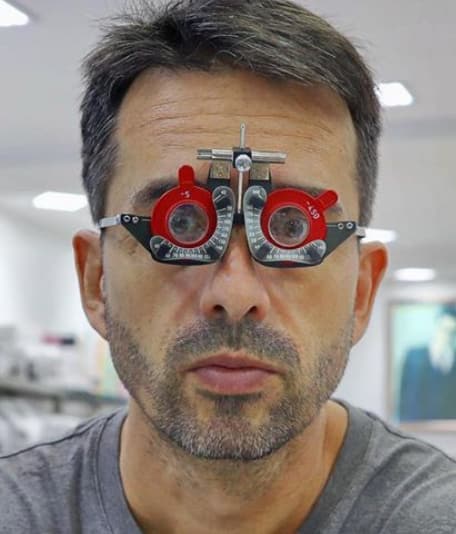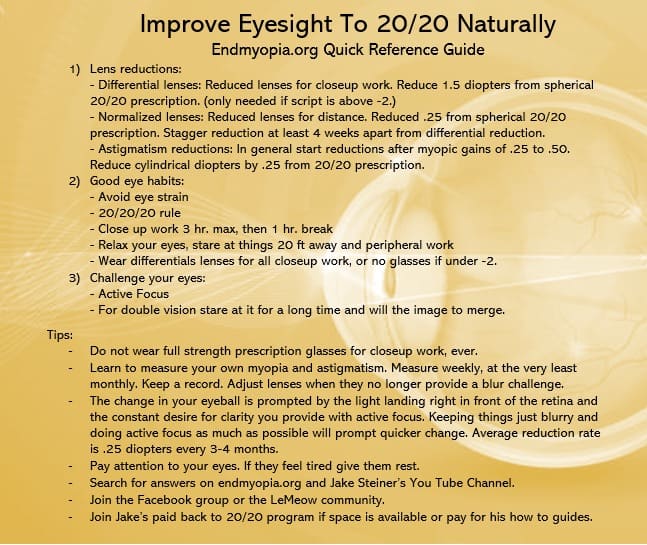This Is Endmyopia
 Hi, Im Jake Steiner.
Hi, Im Jake Steiner.
20 years ago I began a journey to reverse my -5.00 diopter myopia. It took a great deal of experimenting and trial and error to apply theoretical concepts found in clinical journals and peer reviewed studies, though I eventually managed get back my natural 20/20 eyesight.
Over the years I cataloged the many tools, resources, and experiences that made my myopia recovery a reality. Much of it exists now as part of this resource to help and share and connect with fellow myopes, so that more of us could our get natural eyesight back. More about my own antics a bit further on – but first let’s talk a bit about endmyopia® and a few things you may want to know before diving in.
*Don’t leave without checking the not-just-lip-service disclaimer at the bottom. Important details about risks and side effects!
Endmyopia.org is established as an online resource to offer myopes the opportunity to explore science, vision biology, and optics that affect their eyesight.
We advocate an evidence based approach to understand myopia and methods to control it.
Using endmyopia tools, a large number of myopes* have reported significant reductions in diopter dependence with many even achieving natural 20/20 eyesight.
These first hand experiences counter much of the established dogma propagated by retail lens sales advocates. Our approach also raises much (appropriate) skepticism among those not familiar with the biology and studies relevant to myopia.
This is in no small parts because preciously few destinations exist online today that explore myopia as a refractive state rather than some mysterious genetic or indeed any type of medical condition**. Little is available to the general public to point their interest towards the otherwise obscure clinical science, research studies, and extensive published findings discussing the causality and development of human myopia.
The most commonly repeated mainstream concept claims that your myopia is genetic, that nothing about it is known, and that nothing can be done about it.
Why is this one-sided narrative so prevalent?
Sadly today’s narrative about myopia is largely controlled by a 100 billion dollar industry with the express aim of selling lenses to their customer base. There exists a vast chasm between the retail sales interest and clinical science in this arena. For anyone looking to explore answers about their visual acuity deficit, the overwhelming consensus created by for-profit interest is – that nothing can be done (besides of course buying more lenses at shockingly inflated prices).
The obvious problem here is that information that is profitable to any given group, tends to spread.
We want to change the one-sided nature of the narrative. We want expose the sales strategy and the glasses trap.
The discussion here on endmyopia centers around the biological reality that myopia is simply a refractive state. A state that is affected by the individual’s environment and vision habits, as well as ‘treatment’ of any existing myopia via minus lenses. Our position is that myopia can very simply be prevented (and possibly even reversed) through stimulus and habits. This is a highly unprofitable premise and consequently unpopular with the retail lens sales establishment.
There is nothing to buy, or sell, or services to render via this narrative. Consequently, no financial benefit is created which would spread this alternate take on myopia as a ‘condition’ facing an increasing part of humanity.
And despite all of this, the endmyopia community continues to grow.
Endmyopia® Is The Reduced Lens Method™
Many of our tools, strategies, and systems are available to everyone. Our large community-sourced wiki explains all aspects of endmyopia for vision improvement in detail, and can be added on and updated by everyone.
Everything we share is based on community experiences, experiments, and ongoing exploration of best possible results.We make all relevant experiences and outcomes public, and continue to work on tools to help improve access to statistics and data.
We do offer the option of paid support, structured courses, and member communities – which are not free, but also not required to be able to use and access our system to improve your eyesight.
Paid options enable us to increase our reach and continue building better infrastructure.Endmyopia is among the first resources of its kind to reach a large (and growing) audience.
Endmyopia is among the first resources of its kind to reach a large (and growing) audience.
Here’s more reality that we have to consider:
Clinical studies are boring.
People are busy.
Lenses offer an immediate fix, even if causality remains murky.
Alternate approaches so far have primarily centered around eye exercises, which have largely proven ineffective.
Endmyopia has taken the novel (and somewhat controversial) approach of combining science, biology, and clinical research with an emotional and human aspect – to create an engaging narrative while looking for actual solutions to the myopia problem.
On this site you will find a lot of clinical studies, research, and dissection of vision biology, stimulus, and results of practical approaches of managing myopia. This can easily become a dense and boring topic lost on much of a general audience. Countering the dry nature of clinical data and biology is the somewhat divisive and frequently emotionally charged character of the narrator of these subjects – Jake Steiner.
Jake directs the narrative and engages the reader with emotional context. Endmyopia is not only science and research and mechanistic data, but also very clearly part of a human experience (and all the many failings that go along with it).
Having reversed his own -5.00 diopter myopia, Jake tends to pull few punches when faced with the optometry dogma along with discussing actionable strategies for myopia control.
“Love it or hate it”, Jake says. “As long as it’s not indifference. Indifference is myopia.”
Endmyopia now engages a large community of tens of thousands of myopes reducing their lens dependence, a free member forum, a rapidly growing Facebook group, a YouTube channel with millions of watch minutes, and this site with many millions of reader sessions. While far from an unmitigated success against the mainstream narrative of an ‘incurable genetic condition’, endmyopia continues making inroads on established industry dogma.
Getting more people to discover Google Scholar, the power of instant access to millions of pieces of clinical research, of access to many thousands of fellow myopes improving their eyesight, all is part of the collective adventure of endmyopia.
This introduction, to add some context to what may be your possibly first encounter of Jake Steiner – and his many rants and missives here.
Curious about the Cliff Notes of what makes endmyopia work? Here’s a summary created by members of our forum:

Important Disclaimer
It should go without saying almost: This is all very highly experimental. We’re not doctors, we’re not treating illnesses, and all of this hasn’t ever been done before – not at this sort of global scale, for almost two decades, by people of all walks of life.
We’re figuring out what works, by trial and error. And feedback from the community. This should be the establishment’s job, but there’s really no tempting profit in reversing myopia and killing the revenue stream of endlessly selling symptom treatments.
These resources are freely available. You’re responsible for being cautious, realizing that you’re on your own with this experiment, that there is nobody to blame for any adverse outcomes. Be patient, take it slow, make no dramatic changes, don’t strain yourself. An incredibly common mistake is reducing too much, too fast. It’s a major issue and can cause all sorts of adverse results that we then get blamed for. Do not reduce faster than suggested, do not monkey with diopters till you know what you’re doing, realize that eyes respond slowly and that anything more than a little stimulus just creates undue eye strain.
Some issues people have reported:
1) Increased floaters. We don’t have any clear evidence what may be causing this, though when prodded most who experience it admit to having a huge amount of close-up time and often reducing too much, trying to push their progress. Not a great idea and something I always caution people not to do (I’m also usually ignored).
2) Headaches. Not at all common, but has been reported. Usually this means a poorly chosen diopter change. Also do not change habits dramatically. Another common error is to go uproot your entire day and flow and then be totally lost when things are not working. Small changes. Slowly. That way it’s easy to walk back any one thing you find to be counterproductive.
3) Astigmatism symptoms. Some of this is normal, if only to a very small degree and in adverse / poor lighting conditions. Anymore than this – you probably guessed it by now: You reduced too much, too fast. Maybe you get away with it once or twice but eventually it catches up to you. I’ve been doing this for nearly two decades and with thousands of participants. Trust me when I say, you’re not going to be that one person who can magically get rid of half of your myopia in a matter of weeks or months. 1 diopter per year is doable and means things are going well. Any much more than that and somebody is selling you unicorns.
4) Jake being cranky / not helpful / an a**shole. This is also normal. Having answered the same questions what feels like a million times, having answered those questions in places that are easy to find (search function), people generally ignoring tools built to answer their questions … eventually you get Mr. VonCrankypants. I’ve also spent ridiculous money building and maintaining all of what you see, and many thousands of hours. I have nothing to gain or lose from somebody liking me or not liking me, doing endmyopia or not doing endmyopia. I’ll possibly be short or snarky or otherwise difficult. It’s half my nature (hey that’s why this resource exists in the first place, not accepting things easily), and half the never-ending recurring requests for me to spend time for free, helping people with things they could help themselves with.
5) Not everything being free. Also normal. It costs more money than most people would think, keeping things going. And some people appreciate the option for structure and support and accountability, and a place to find non-cranky Jake who actually responsive and helpful. Which is what you get with the paid resources, there’s no snark or sarcasm when we’re exchanging value.
The only reason free resources even exist still at this point, despite the endless nagging and entitlement from the Internet, is that I too have been broke at some point and will forever have sympathy for that. The paid resources are quite a bit better, I put more effort into them, there are less riff-raff plz bros (like on the FB group) and it’s all together a more worthwhile option if you’re serious about eyesight.
And that’s it. Go learn some biology, be kind to your eyes, realize that there’s fine line between Internet unicorn crazy talk, and actual worthwhile experiments. Nobody but you can figure out what’s what, and it’ll take time regardless.
Cheers,
-Jake
About Endmyopia®
 Hi, Im Jake Steiner.
Hi, Im Jake Steiner.
20 years ago I began a journey to reverse my -5.00 diopter myopia. It took a great deal of experimenting and trial and error to apply theoretical concepts found in clinical journals and peer reviewed studies, though I eventually managed get back my natural 20/20 eyesight.
Over the years I cataloged the many tools, resources, and experiences that made my myopia recovery a reality. Much of it exists now as part of this resource to help and share and connect with fellow myopes, so that more of us could our get natural eyesight back. More about my own antics a bit further on – but first let’s talk a bit about endmyopia and a few things you may want to know before diving in.
Endmyopia.org is established as a resource to offer myopes the opportunity to explore science, vision biology, and optics that affect their eyesight.
We advocate an evidence based approach to understand myopia and methods to control it.
Using endmyopia tools, a large number s of myopes* have reported significant reductions in diopter dependence with many even achieving natural 20/20 eyesight.
These first hand experiences counter much of the established dogma propagated by retail lens sales advocates. Our approach also raises much (appropriate) skepticism among those not familiar with the biology and studies relevant to myopia.
This is in no small parts because preciously few destinations exist online today that explore myopia as a refractive state rather than some mysterious genetic or indeed any type of medical condition**. Little is available to the general public to point their interest towards the otherwise obscure clinical science, research studies, and extensive published findings discussing the causality and development of human myopia.
The most commonly repeated mainstream concept claims that your myopia is genetic, that nothing about it is known, and that nothing can be done about it.
Why is this one-sided narrative so prevalent?
Sadly today’s narrative about myopia is largely controlled by a 100 billion dollar industry with the express aim of selling lenses to their customer base. There exists a vast chasm between the retail sales interest and clinical science in this arena. For anyone looking to explore answers about their visual acuity deficit, the overwhelming consensus created by for-profit interest is – that nothing can be done (besides of course buying more lenses at shockingly inflated prices).
The obvious problem here is that information that is profitable to any given group, tends to spread.
We want to change the one-sided nature of the narrative.
The discussion here on endmyopia centers around the biological reality that myopia is simply a refractive state. A state that is affected by the individual’s environment and vision habits, as well as ‘treatment’ of any existing myopia via minus lenses. Our position is that myopia can very simply be prevented (and possibly even reversed) through stimulus and habits. This is a highly unprofitable premise and consequently unpopular with the retail lens sales establishment.
There is nothing to buy, or sell, or services to render via this narrative. Consequently, no financial benefit is created which would spread this alternate take on myopia as a ‘condition’ facing an increasing part of humanity.
And despite all of this, the endmyopia community continues to grow.
Curious about the Cliff Notes version of what defines some of the core premise of our approach? Forum members created this quick summary:

And here, a quick animated 2 minute video on Jake’s myopia reversal:
Endmyopia® Is Open Source
All of our tools, strategies, and systems are available openly to everyone. Our large community-sourced wiki explains all aspects of endmyopia for vision improvement in detail, and can be added on and updated by everyone.
Everything we share is based on community experiences, experiments, and ongoing exploration of best possible results. We make all relevant experiences and outcomes public, and continue to work on tools to help improve access to statistics and data.
We do offer the option of paid support, structured courses, and member communities – which are not free, but also not required to be able to use and access our system to improve your eyesight.
Paid options enable us to increase our reach and continue building better infrastructure. Endmyopia is among the first resources of its kind to reach a large (and growing) audience.
Here’s more reality that we have to consider:
Clinical studies are boring.
People are busy.
Lenses offer an immediate fix, even if causality remains murky.
Alternate approaches so far have primarily centered around eye exercises, which have largely proven ineffective.
Endmyopia has taken the novel (and somewhat controversial) approach of combining science, biology, and clinical research with an emotional and human aspect – to create an engaging narrative while looking for actual solutions to the myopia problem.
On this site you will find a lot of clinical studies, research, and dissection of vision biology, stimulus, and results of practical approaches of managing myopia. This can easily become a dense and boring topic lost on much of a general audience. Countering the dry nature of clinical data and biology is the somewhat divisive and frequently emotionally charged character of the narrator of these subjects – Jake Steiner.
Jake directs the narrative and engages the reader with emotional context. Endmyopia is not only science and research and mechanistic data, but also very clearly part of a human experience (and all the many failings that go along with it).
Having reversed his own -5.00 diopter myopia, Jake tends to pull few punches when faced with the optometry dogma along with discussing actionable strategies for myopia control.
“Love it or hate it”, Jake says. “As long as it’s not indifference. Indifference is myopia.”
Endmyopia now engages a large community of tens of thousands of myopes reducing their lens dependence, a free member forum, a rapidly growing Facebook group, a YouTube channel with millions of watch minutes, and this site with many millions of reader sessions. While far from an unmitigated success against the mainstream narrative of an ‘incurable genetic condition’, endmyopia continues making inroads on established industry dogma.
Getting more people to discover Google Scholar, the power of instant access to millions of pieces of clinical research, of access to many thousands of fellow myopes improving their eyesight, all is part of the collective adventure of endmyopia.
This introduction, to add some context to what may be your possibly first encounter of Jake Steiner – and his many rants and missives here.
